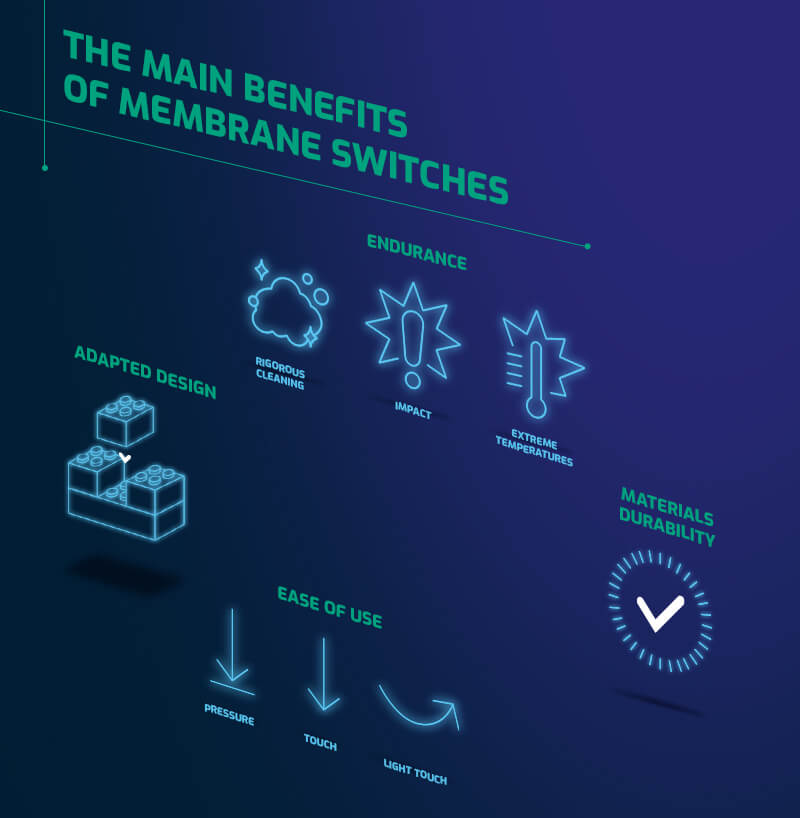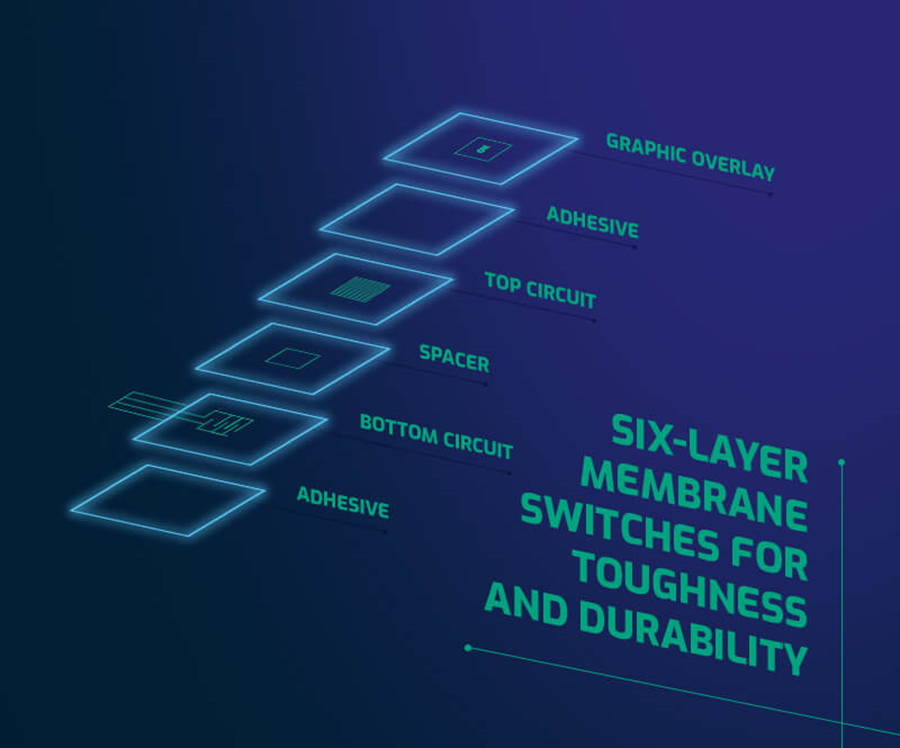How membrane switch drives sustainability in electronic product design
The Manufacturing Refine Behind Membrane Layer Switch: What You Need to Know
The production process behind membrane switches over combines cautious style, material option, and high quality control. It begins with understanding the details of membrane layer switch layout and advances through numerous stages, including product choices and printing strategies. Each stage plays a vital role in making certain performance and sturdiness. The complexities of layer building and construction and the rigorous screening criteria may disclose insights that are not promptly apparent. What exists past these foundational aspects?
Understanding Membrane Switch Over Layout
Although membrane layer buttons may appear straightforward initially look, their design includes detailed considerations that ensure capability and durability. The design process begins with a detailed understanding of user requirements, including the interface's designated application and ecological aspects. Comfort designs is a key element, as the layout should assist in simplicity of usage while making sure that responsive comments satisfies individual expectations.Moreover, the layering of elements, such as graphic overlays, sticky layers, and conductive traces, need to be exactly engineered. membrane switch. This layered configuration not only affects the button's responsiveness yet likewise affects its durability. Attention is provided to the sealing strategies used to secure versus wetness and dust, which can endanger performance. Furthermore, design factors to consider encompass appearances, where color pattern and visual clarity boost individual experience. Ultimately, the design of membrane layer changes balances capability, individual experience, and resilience, ensuring that they fulfill the demands of various applications properly
Materials Used in Membrane Layer Switch Production
When choosing products for membrane button production, it is necessary to contemplate both efficiency and sturdiness. The primary products include polyester and polycarbonate movies, which provide adaptability and strength. These movies are typically covered with adhesive to assure proper bonding to substratums. Conductive inks, generally made up of silver or carbon, are crucial for developing electrical connections within the button, permitting trustworthy operation.Additionally, a protective layer, such as a difficult layer, is frequently put on boost scratch resistance and durability. The selection of backing material, such as acrylic or foam, can significantly influence the button's tactile feel and general user experience. Furthermore, various ecological variables, consisting of temperature level and moisture, ought to guide material choice to guarantee peak performance in particular applications. Inevitably, the appropriate mix of products adds to the membrane switch's functionality and lifespan, making informed choices vital for makers.
The Printing Refine: Creating Video and Text
The printing procedure in membrane switch manufacturing plays a considerable function in creating premium graphics and text. Different graphic design techniques are used to assure aesthetic charm and performance, while cautious ink selection methods are essential for durability and efficiency. Recognizing these aspects is essential for achieving best outcomes in membrane layer switch design.
Graphic Design Techniques
Graphic style techniques play a necessary role in the printing procedure of membrane layer switches, as they specify just how graphics and message will ultimately appear on the final product. Reliable graphic style entails the strategic use of shades, formats, and fonts to enhance readability and visual charm. Developers usually utilize vector graphics for scalability, making sure that photos continue to be sharp at various sizes. Additionally, interest to contrast and placement is important, as it influences individual communication and visual top quality. The unification of branding components, such as logo designs, must be handled with care to maintain brand integrity. Overall, thoughtful graphic design techniques contribute considerably to the functionality and attractiveness of membrane buttons, influencing customer experience and item efficiency.
Ink Choice Techniques
Selecting the appropriate ink is important for achieving the desired aesthetic top quality and longevity in membrane layer switch production. Numerous ink kinds are used, including solvent-based, water-based, and UV-curable inks. Each type supplies distinctive attributes, such as attachment, resistance, and adaptability to ecological aspects. Solvent-based inks are typically favored for their longevity and lively colors, while water-based inks are extra ecologically pleasant however may have restrictions in adhesion. UV-curable inks give rapid healing and robust efficiency. Additionally, shade matching techniques assure that the selected inks straighten with design requirements. Ultimately, the option of ink must take into consideration elements such as application approach, substrate compatibility, and end-use demands to attain exceptional lead to membrane layer switch graphics and message.
Layer Construction and Setting Up

Material Selection Refine
A mindful selection of materials is necessary in the manufacturing process of membrane buttons, as it straight influences capability and durability. The main products used include polyester, polycarbonate, and different conductive inks. Polyester is frequently preferred for its superb resistance to chemicals and abrasion, making it suitable for severe atmospheres. Polycarbonate, on the various other hand, gives superior clarity and impact resistance, which is useful for applications needing presence and effectiveness. Conductive inks, typically composed of silver or carbon, are vital for creating reputable electrical pathways. Additionally, the option of sticky materials impacts the overall integrity of the button - membrane switch. Evaluating factors such as ecological direct exposure, responsive comments, and aesthetic demands guides manufacturers in selecting the most effective products for their certain applications
Layer Bond Methods
Adhering layers in membrane layer button building is an important process that assures capability and durability. Various attachment strategies are utilized to secure ideal bonding in between layers, which normally include making use of adhesives, warm, and pressure. Pressure-sensitive adhesives (PSAs) are commonly made use of for their simplicity of application and immediate bonding capacities. Furthermore, thermal bonding strategies can be used, where heat is made use of to activate glue buildings, protecting a strong bond. The option of adhesion approach greatly depends upon the products included and the details application demands of the membrane layer switch. Correct positioning and uniform application of adhesives are important to stop problems, safeguarding the switch operates properly throughout its intended life expectancy.
Quality Assurance Procedures
Assuring quality control throughout the layer building and construction and assembly of membrane layer buttons is important for preserving efficiency and reliability. This process normally entails several see important actions, including extensive examinations at each stage of production. Makers make use of innovative testing methods, such as peel tests and bond evaluations, to confirm the honesty of layer bonds. In addition, aesthetic inspections are conducted to identify any type of issues in printing or product incongruities. Environmental problems, such as temperature level and moisture, are carefully monitored to guarantee perfect curing and adhesion. Furthermore, routine calibration of equipment helps maintain precise manufacturing criteria. By applying these top quality control actions, makers can considerably minimize the risk of product failing, ensuring that the final membrane layer switches over satisfy the required specifications and consumer expectations.
Evaluating and Quality Assurance Actions

Innovations in Membrane Change Innovation
As innovations in technology continue to develop, membrane layer buttons are gaining from cutting-edge developments that enhance their functionality and individual experience. One significant advancement is the assimilation of capacitive touch modern technology, which enables more instinctive and receptive customer interfaces. This change not just boosts aesthetics but also reduces mechanical wear and tear, extending the lifespan of the switches.Additionally, advancements in visuals overlay products have resulted in improved toughness and resistance to environmental elements such as dampness and UV light. These products now offer improved clarity and brightness, more boosting the aesthetic appeal.Furthermore, the consolidation of smart technology is changing membrane layer switches right into interactive control board, allowing connectivity with IoT tools. This connection fosters a smooth individual experience, leading the way for applications in different industries, from healthcare to customer electronics. Jointly, these advancements position membrane layer changes as crucial parts in contemporary device style.
Frequently Asked Inquiries
The length of time Does the Membrane Switch Over Manufacturing Refine Take?
The duration of the membrane layer switch production process can read the full info here differ considerably. Aspects such as complexity, materials made use of, and production quantity influence timelines, with normal manufacturing ranging from a couple of days to several weeks for completion.
What Are the Usual Applications for Membrane Buttons?
Membrane layer switches are frequently utilized in different sectors, including automobile controls, house appliances, medical tools, and consumer electronics (membrane switch). Their adaptability and resilience make them suitable for applications requiring easy to use user interfaces and reliable performance in diverse atmospheres
Can Membrane Layer Switches Be Personalized for Certain Demands?

What Is the Lifespan of a Typical Membrane Change?
The life expectancy of a regular membrane layer button differs, however normally, it varies from 1 to 5 million cycles. Variables such as use, setting, and worldly high quality considerably affect longevity and total efficiency gradually.

Are Membrane Layer Changes Ecologically Friendly?
The ecological kindness of membrane switches over differs. Some materials made use of might not be recyclable, while others can be environment-friendly. The overall influence depends upon manufacturing materials and techniques, requiring careful factor to consider during option and disposal. The manufacturing procedure behind membrane switches combines cautious design, product selection, and top quality control. It begins with recognizing the complexities of membrane layer switch layout and advances via various phases, including product choices and printing techniques. When picking materials for membrane button production, it is crucial to consider both efficiency and resilience. A mindful selection of materials is necessary in the production process of membrane layer switches, as it straight affects functionality and sturdiness. The option of bond method mainly depends on the products involved and the particular application needs of the membrane switch.